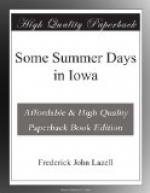At the foot of a figwort stalk in the pasture, shielded by a little sprig of choke-cherry and a wisp of grasses, a new nest is being builded. That is why the chewink sings so happily from dawn till dark. His summer song is now heard more often than his spring song. Through April, May and June he sings:
Fah do do’-do’-do’-do’-do’
But now, this song is heard more often:
Me’ fah’-fah’-fah’-fah’-fah’
This song is more appropriate to the summer. There is more of fullness and beauty in it, more of the quality of the woodthrush’s songs, for which it is often mistaken.
* * * * *
From a tiny hawthorne bush, no higher than a collie’s back, a field sparrow flies nervously to a low limb of a hickory tree and begs that her nest be not disturbed. It is neatly placed in the middle of the bush about a foot from the ground, made of medium grasses and rootlets and lined with finer grasses and horsehair. The three bluish-white eggs with rufous markings at the larger end are the field-sparrow’s own. Into a nest found a month ago, at the foot of a yarrow stalk, the cowbird had sneaked three speckled eggs, leaving only one of the pretty eggs of the field-sparrow. At that time the cowbirds were to be seen everywhere; they chattered every morning in the trees, and the females left their unwelcome eggs in nearly every nest. One little red-eyed vireo’s nest had five cowbirds’ eggs,—none of her own. But the birds which are building now are generally safe from the parasite. Only rarely is a cowbird’s egg found after the middle of July. No cowbirds have been seen since the first week of the month, save the young one on the stump, which the field-sparrow was feeding this morning. They disappear early, seeking seclusion for the moulting. When they emerge from their hiding places they form into flocks, spending their days in the grain-fields and near the rivers where the food is most abundant and easy to procure. At nightfall they congregate, like the red-winged blackbirds, in the sand-bar willows on the river islands.
* * * * *
Daintily flitting from one branch to another, the redstart weaves threads of reddish gold and black, like strands of night and noon, among the old trees. He has wandered over through the woods from the creek, where his mate built a cup-like nest in a crotch toward the top of a slender white oak. Busy always, he stays but a few moments and then passes on as silently as a July zephyr. The halting voice of the preacher, the red-eyed vireo, comes out of the thicket; then, from an oak overhead, where a little twig is trembling, the softer voice of the warbling vireo queries: “Can’t you see it’s best to sing and work like me?”, with the emphasis on the “me.”




